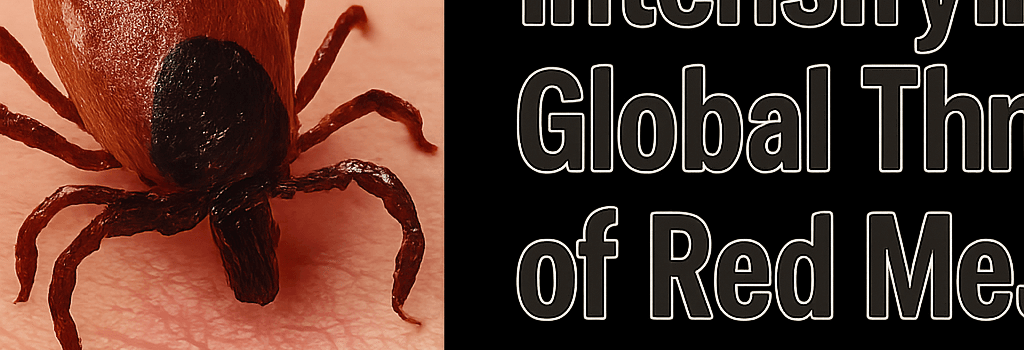Tick Bites: Intensifying Global Threat of Red Meat Allergy

Hours after savoring a perfectly grilled steak, some individuals experience sudden itching, swelling and, in severe cases, anaphylaxis. This delayed reaction, known as alpha-gal syndrome, arises from a tick bite months earlier. Once considered rare and regional, alpha-gal syndrome is now recognized across the US and six continents, driven by multiple tick species, environmental changes and improved diagnostics.
What Is Alpha-gal Syndrome?
Alpha-gal syndrome is an IgE-mediated allergy to galactose-alpha-1,3-galactose (alpha-gal), a carbohydrate found in most non-primate mammalian tissues. Unlike classic protein-based allergies, alpha-gal reactions manifest 2–6 hours after ingesting mammalian meat or exposure to related products:
- Red meat (beef, pork, lamb)
- Dairy products (milk, cheese, butter)
- Gelatin-based foods and pharmaceuticals (vaccines, heparin)
- Cosmetics containing animal-derived additives
Molecular Immunology of Sensitization
Upon a tick bite, large quantities of alpha-gal–bearing glycoproteins in tick saliva prime the host’s immune system. Dendritic cells internalize these glycans and present them via MHC II to CD4+ T helper cells, triggering a Th2-skewed response. B cells undergo class switching to produce anti–alpha-gal IgE. Subsequent ingestion of alpha-gal–containing foods cross-links IgE on mast cells and basophils, releasing histamine, tryptase and inflammatory cytokines (IL-4, IL-5), which drive the delayed, multisystem reaction.
Tick Vectors and Geographic Expansion
Originally linked to the lone star tick (Amblyomma americanum) in the Southeastern US, alpha-gal sensitization is now attributed to multiple vectors:
- Amblyomma americanum – predominant in the US Southeast and Midwest
- Ixodes scapularis (black-legged tick) – spreads Lyme disease and alpha-gal in the Northeast
- Ixodes ricinus – implicated in Europe
- Hyalomma marginatum – emerging in the Mediterranean and Central Asia
Climate change, reforestation and suburban deer populations have extended tick habitats. A 2024 CDC mapping study estimates over 450,000 US cases with positive serology; modeling predicts a 25% range increase for key vectors by 2030.
Clinical Presentation and Comorbidities
Typical symptoms arise 2–6 hours post–alpha-gal exposure:
- Cutaneous: Urticaria, angioedema, pruritus
- Gastrointestinal: Severe abdominal pain, vomiting, diarrhea
- Respiratory/Cardiovascular: Dyspnea, hypotension, anaphylaxis
“We’re seeing increased cardiac inflammation in alpha-gal patients, even without overt allergic reactions,” notes Dr. Samantha Lee, an immunologist at Johns Hopkins. “This underscores the need for long-term monitoring.”
Diagnostic Advances
Traditional diagnosis relies on patient history and serum IgE assays. Recent innovations include:
- Multiplex ImmunoCAP® assays – simultaneous detection of alpha-gal and other tick-borne allergens
- Component-Resolved Diagnostics – identifies IgE responses to specific tick salivary proteins
- Basophil Activation Tests (BAT) – functional assay for basophil CD63 upregulation
- Point-of-Care Lateral Flow Tests – in development to enable rapid screening in endemic areas
Management Strategies
Key recommendations for patients with confirmed alpha-gal syndrome include:
- Avoid all mammalian meat and derivatives for 2–3 years to allow IgE titers to decline
- Read labels for hidden alpha-gal sources (carrageenan, gelatin)
- Carry an epinephrine auto-injector for emergency use
- Implement rigorous tick-avoidance measures:
- Wear permethrin-treated clothing
- Apply DEET or picaridin repellents
- Perform daily tick checks and shower within 2 hours of outdoor activity
Climate Change and Tick Ecology
Rising temperatures and altered precipitation patterns accelerate tick life cycles and expand overwintering survival. Satellite-based habitat models, powered by AI, predict new endemic zones in northern Europe and Canada by 2028. Integrating remote sensing with genomic surveillance of tick populations helps public health agencies target control efforts more precisely.
Biotech Innovations and Vaccine Research
Efforts to develop vaccines against alpha-gal syndrome are underway:
- mRNA Platforms: Encode tick salivary antigens to induce protective IgG, blocking sensitization
- Recombinant Subunit Vaccines: Target key glycoproteins identified via proteomic analysis of tick saliva
- CRISPR-Edited Ticks: Experimental gene drives aim to disrupt alpha-gal–carrying enzymes in tick populations
Several biotech startups have entered clinical trials, leveraging AI-driven antigen discovery and lipid nanoparticle delivery systems.
Future Directions
Despite rapid progress, key questions remain:
- Why do only some tick bites provoke alpha-gal sensitization?
- Can vector-targeted vaccines halt the spread of multiple tick-borne diseases?
- How will continued environmental change reshape global risk maps?
Over the next decade, interdisciplinary collaboration—combining entomology, immunology, bioinformatics and climate science—will be vital in developing predictive models, novel diagnostics and preventive vaccines.
Protect Yourself
Next time you venture into grassy or wooded areas, take these precautions:
- Wear long sleeves and pants; treat them with permethrin.
- Use EPA-registered repellents on skin and gear.
- Inspect your body and clothing immediately after outdoor activities.
- Shower and launder clothes in hot water.
Early recognition and avoidance remain the best defenses against this emerging tick-borne allergy.